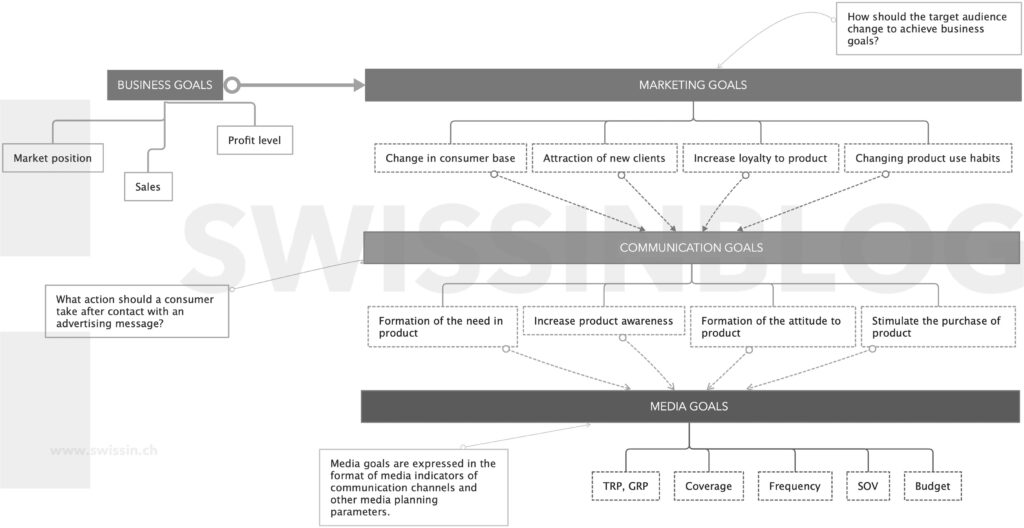—
Without correctly set marketing goals, it is difficult to write an effective marketing strategy, approve an effective marketing policy, and implement a marketing plan to promote a product. Strategic goals in marketing are the basis of any business, have their classification and a clear order of formation. In The article, we will talk about the global practice of developing the marketing goals of an enterprise, describe each element of the tree of strategic objectives, analyse the basic rules for setting long-term and short-term marketing goals so you can use this knowledge in practice.
Background information
We form the strategic marketing objectives of any business in a strict sequence inside of “tree of goals” (or the “strategic goals map”), and it looks like this:

The goal tree is a single interrelated system of long-term and short-term goals of the organisation. The basis of this set of goals is global, long-term business goals in the industry. And to achieve global goals, operational and tactical it already defines tasks, which serve as short-term goals.
When forming goals, remember that it is more convenient to work and analyse the achievement of goals set by the SMART method.
Let us briefly discuss the above classification of strategic marketing objectives and consider each type of marketing aim in more detail:
Business goals
Business objectives are the starting point for developing the purposes of a marketing plan. They become the basis for setting lower-level marketing goals and determining the long-term vector of the company’s development in the market, directly related to the mission of the enterprise.
The primary goal of any business is to increase profits, so we should set clear objectives for the company in three directions: the company’s position in the segment or a place in the market, sales, profit level and rate of return on sales. Business objectives are the main financial objectives of the enterprise.
An example of a company’s strategic business goals:
– Keep market leadership;
– Become number 3 in the segment of detergents;
– Achieve sales growth outpacing market growth;
– Profit and sales growth of 20%;
– Keep profitability at 65%.
Marketing goals
Strategic marketing objectives answer the question: “How should the target audience and behaviour of the target audience change to achieve the business goals set?” The right goals of marketing activities are expressed in:
– Terms of improving or changing the consumer base;
– The growth potential of the company’s audience;
– Changes in buying and using habits; increasing loyalty to the company’s product.
An example of an organisation’s main strategic marketing objectives:
– Attract a new audience to the consumption of the brand;
– Increase the frequency of consumption and use of goods from 1 time per week to daily use;
– To attract to the consumption of the product of all family members;
– Increase loyalty to the product among consumers 35+ high income;
– Increase the frequency of trial purchases among young audiences.
Communication goals
The main question for communication objectives is: “What action should the consumer take after contacting the advertising message?” From communication, we form goals for major advertising campaigns and personalised marketing communications. The choice of creative (what and how to tell the consumer), the selection of communication channels (where to show the advertising message) and the frequency of contact with the advertising message depend on the communicative goals.
There are four primary communicative goals for an advertising campaign for a product: forming a need for a category, increasing product awareness, forming a certain attitude to a product, and encouraging the purchase of a product.
Read more about the principles of defining and setting communication goals in marketing in our upcoming article: “2+2 communication goals of the company’s marketing activities”.
Example of communication objectives of marketing activities:
– Improve the culture of hair care: every time after using the main product, use an extra product for extra benefits;
– 50% of the target audience after the advertising campaign should recognise the brand visually;
– Strengthen the image characteristics of the product: serious, professional, efficient, will always help, confident, purposeful;
– Every fifth representative of the target audience after contacting the advertising message should think about buying a product.
Media goals
Media goals are expressed in the form of critical media indicators, communication channels and other parameters that should be considered in the media planning process. Often these goals include the size of the advertising budget.
An example of media goals:
– To ensure coverage of 90% of the entire target audience of the brand;
– Activate communication channels with high involvement;
– To achieve leadership in the media channel “Today’s press”;
– Provide 90% coverage of key sales regions.
GOAL-SETTING RESULT
As a result, when developing a marketing plan, before starting an advertising campaign, you should have the following short form of goals:

IMPORTANT:
We must monitor the fulfilment of any goal. Analyse the reasons for exceeding or not fulfilling the goals. Take into account the accumulated experience in further marketing activities.
0 Comments